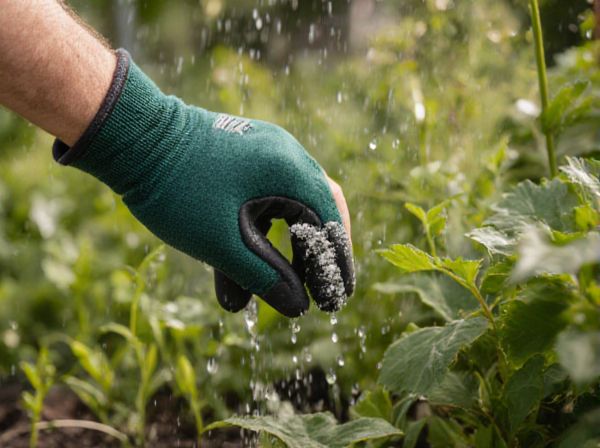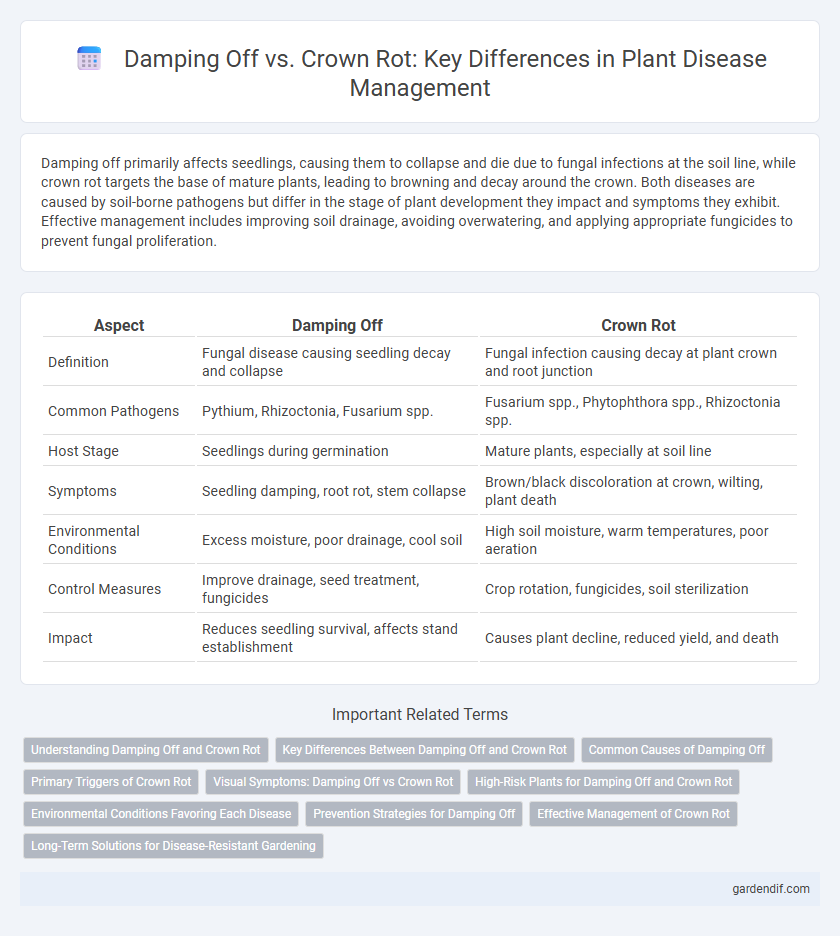
Damping off vs Crown rot Illustration
Damping off primarily affects seedlings, causing them to collapse and die due to fungal infections at the soil line, while crown rot targets the base of mature plants, leading to browning and decay around the crown. Both diseases are caused by soil-borne pathogens but differ in the stage of plant development they impact and symptoms they exhibit. Effective management includes improving soil drainage, avoiding overwatering, and applying appropriate fungicides to prevent fungal proliferation.
Table of Comparison
| Aspect | Damping Off | Crown Rot |
|---|---|---|
| Definition | Fungal disease causing seedling decay and collapse | Fungal infection causing decay at plant crown and root junction |
| Common Pathogens | Pythium, Rhizoctonia, Fusarium spp. | Fusarium spp., Phytophthora spp., Rhizoctonia spp. |
| Host Stage | Seedlings during germination | Mature plants, especially at soil line |
| Symptoms | Seedling damping, root rot, stem collapse | Brown/black discoloration at crown, wilting, plant death |
| Environmental Conditions | Excess moisture, poor drainage, cool soil | High soil moisture, warm temperatures, poor aeration |
| Control Measures | Improve drainage, seed treatment, fungicides | Crop rotation, fungicides, soil sterilization |
| Impact | Reduces seedling survival, affects stand establishment | Causes plant decline, reduced yield, and death |
Understanding Damping Off and Crown Rot
Damping off is a fungal disease primarily affecting seedlings, causing stem decay at the soil line and rapid plant collapse, often linked to pathogens like Pythium, Rhizoctonia, and Fusarium. Crown rot targets mature plants, leading to necrosis at the crown, wilting, and eventual plant death, commonly caused by fungi such as Phytophthora and Fusarium species. Both diseases thrive in overly moist conditions but differ in their stage of infection and affected plant tissues, necessitating distinct management strategies.
Key Differences Between Damping Off and Crown Rot
Damping off primarily affects seedlings, causing stem collapse at the soil line due to fungal pathogens like Pythium, Rhizoctonia, and Fusarium, while crown rot targets mature plants, leading to decay at the crown and root junction often caused by Phytophthora or Fusarium species. Damping off symptoms emerge quickly after germination, resulting in sudden seedling death, whereas crown rot develops gradually, causing wilting, yellowing, and eventual plant decline. Management of damping off focuses on soil sterilization and seed treatment, whereas crown rot control involves improving drainage and using resistant plant varieties.
Common Causes of Damping Off
Damping off is primarily caused by soilborne pathogens such as Pythium, Rhizoctonia, and Fusarium species, which thrive in overly wet, poorly drained conditions. These fungi attack seedlings' roots and stems near the soil surface, leading to rapid wilting and collapse. In contrast, crown rot usually results from pathogens infecting the base of mature plants, often influenced by prolonged moisture stress and soil compaction.
Primary Triggers of Crown Rot
Crown rot primarily develops due to soilborne pathogens such as Fusarium, Phytophthora, and Rhizoctonia species thriving in poorly drained, waterlogged soils. Excess moisture combined with warm temperatures creates an ideal environment for these fungi to infect the plant base, disrupting nutrient uptake and causing tissue decay. Poor soil aeration and plant stress further exacerbate crown rot severity, distinguishing it from damping off which mainly affects seedlings through seed and soilborne pathogens during germination.
Visual Symptoms: Damping Off vs Crown Rot
Damping off causes seedlings to collapse at the soil line, displaying water-soaked, brown lesions and a soft, mushy stem base, often leading to sudden wilting and death. Crown rot symptoms include dark, sunken, necrotic lesions at the plant's crown, with browning and decaying tissue that progresses upward, causing wilting and stunted growth. Both diseases exhibit stem discoloration, but damping off primarily affects young seedlings, while crown rot impacts mature plants at the soil surface.
High-Risk Plants for Damping Off and Crown Rot
High-risk plants for damping off include seedlings of lettuce, tomato, and beans, which are highly susceptible to soil-borne fungi such as Pythium and Rhizoctonia, causing stem collapse and root decay. Crown rot primarily threatens mature plants like cucurbits, peppers, and tomatoes, where fungal pathogens such as Fusarium and Phytophthora invade the plant's crown, leading to wilting and plant death. Effective management requires understanding these vulnerable species to implement targeted fungicidal treatments and cultural practices that minimize fungal spread in nurseries and fields.
Environmental Conditions Favoring Each Disease
Damping off thrives in cool, wet soil with poor drainage and high humidity, conditions that promote fungal spore germination on seeds and young seedlings. Crown rot develops in warm, moist environments where soil remains saturated, enabling pathogens to invade the plant's stem base, often exacerbated by compacted or poorly aerated soil. Both diseases favor environments with excessive moisture, but temperature and soil structure distinctly influence their prevalence and severity.
Prevention Strategies for Damping Off
Effective prevention strategies for damping off include ensuring well-drained soil to avoid excess moisture, using sterilized seeds and planting tools to reduce pathogen spread, and maintaining optimal spacing between seedlings to improve air circulation. Applying fungicide treatments to susceptible crops and practicing crop rotation with non-host plants further diminishes the risk of soil-borne pathogens responsible for damping off. Monitoring environmental conditions such as humidity and temperature allows for timely interventions that protect young seedlings from fungal infections.
Effective Management of Crown Rot
Effective management of crown rot involves crop rotation with non-host plants, well-drained soil to prevent waterlogging, and the use of resistant cultivars to minimize pathogen impact. Applying fungicides containing active ingredients like thiabendazole or azoxystrobin at planting can reduce infection rates. Regular monitoring and prompt removal of infected plants help limit disease spread and improve overall crop health compared to damping off, which primarily affects seedlings at the soil line.
Long-Term Solutions for Disease-Resistant Gardening
Selecting disease-resistant plant varieties is a crucial long-term solution for managing damping off and crown rot, reducing susceptibility to soil-borne pathogens such as Pythium and Phytophthora species. Implementing crop rotation with non-host plants and improving soil drainage through organic matter incorporation significantly decreases pathogen buildup and promotes root health. Integrating biological control agents like Trichoderma and employing soil solarization methods enhance microbial diversity, creating an inhospitable environment for these destructive fungi.
Damping off vs Crown rot Infographic

 gardendif.com
gardendif.com